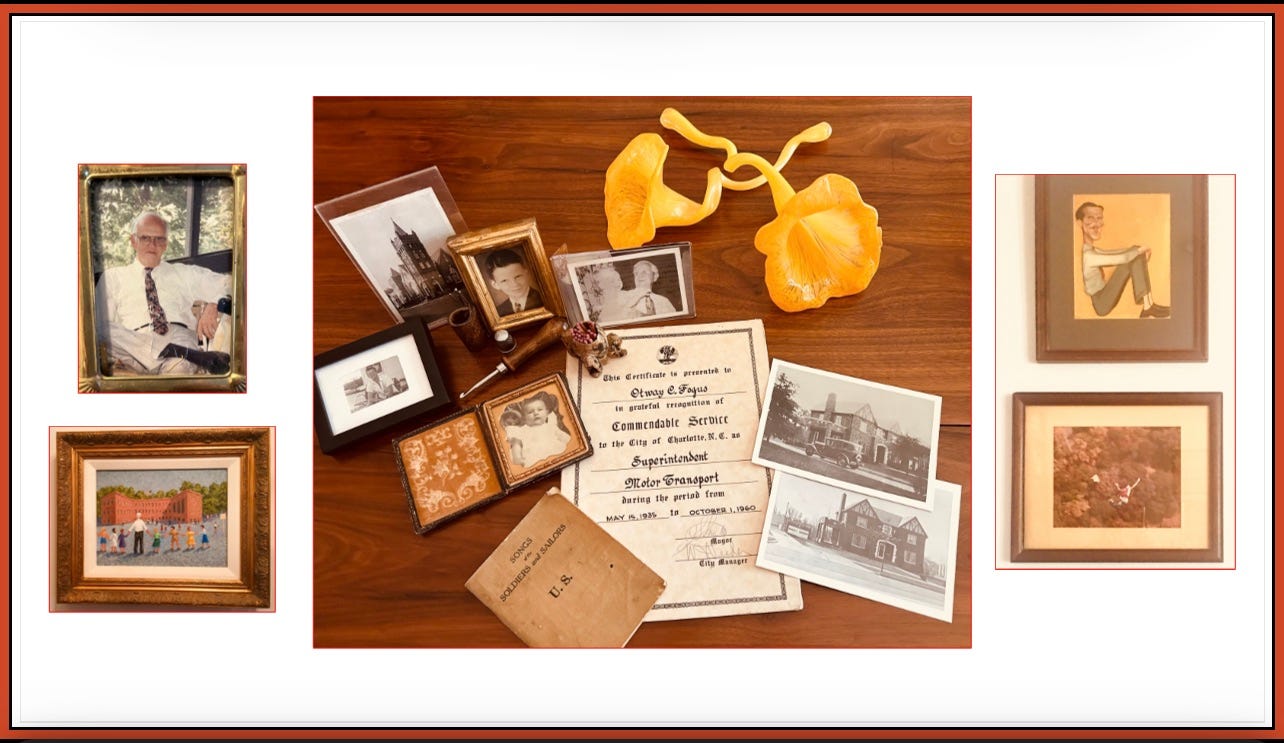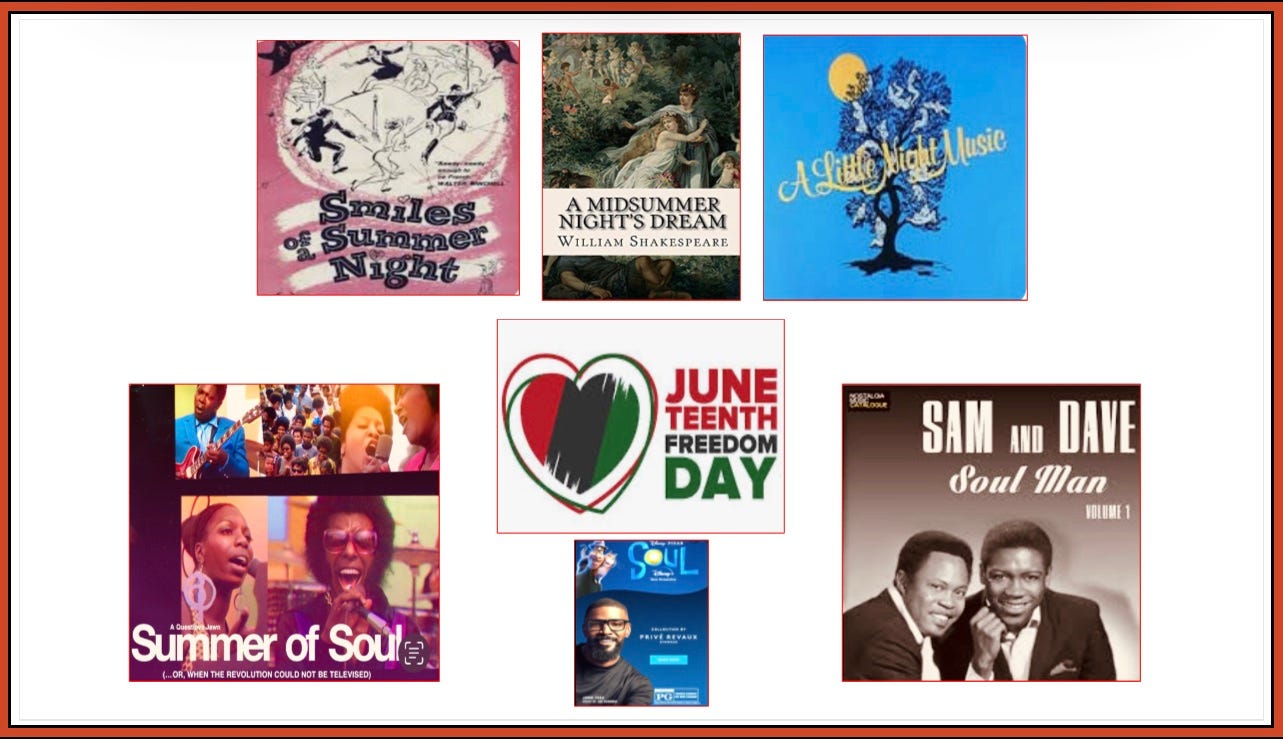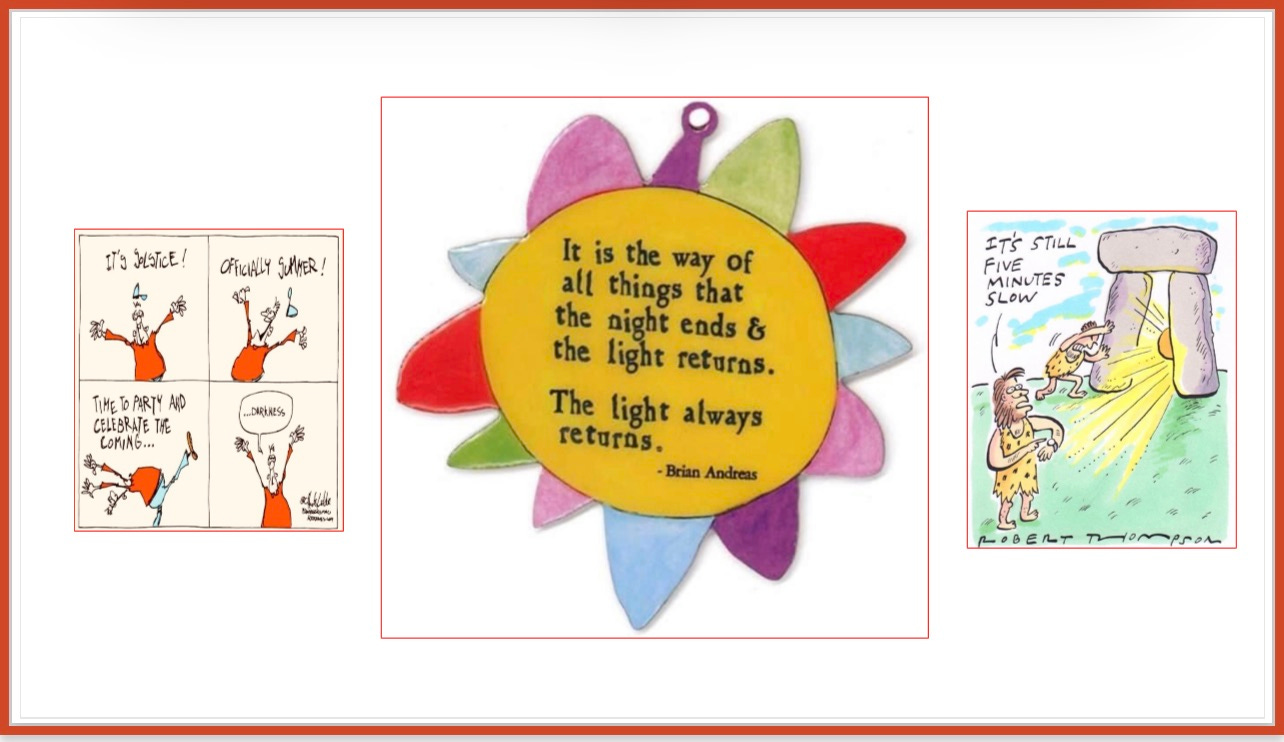Smiles of a Summer Solstice 🌞 2023
Soul Men/Whole Men, the Father's Day gallery (& mostly a breather from news)
Greetings, this day of thanks to all who father — soul men in the vastly varied forms that can take, the surprising graces it can be.
Today’s newShrink celebrates them once again with a bit of a gallery crawl .
Seasonal spirit continues with Monday’s Juneteenth national holiday marking Emancipation and the 1865 official end of slavery, the landmark American anniversary just recognized and passed into federal law two years ago.
And at 10:57 AM EDT Wednesday, the Solstice begins what may be my favorite mix of day, night and season all year.
Cheers first, to the fathers among and within us all…
Soul Men
Of late there are all-too-many, often lamented examples of toxic (unconscious) masculinity (and their unconscious feminine counterpart, too.) There will forever be those who don’t just nudge — they jolt us awake. And rudely!
Today is not about them.
Last week I mentioned Sam, our resident expert and guide on the 2 1/2-hour Slavery to Freedom tour at Monticello. Well-informed, thoughtful and quietly powerful, he’s a retired-engineer and native Virginian from Fredericksburg.
He came to mind as I thought toward Father’s Day themes of conscious, healthy or “positive” psychological masculinity. The six of us were lucky to have Sam to ourselves that Sunday morning, the reservation no-shows probably thanks to the chilly drizzle. Sam epitomized what I recognized as a forbearing, ever-patient, discerning quality not defined or limited by age, race, gender or venue. (Barack Obama embodied this too, in his early 40s, and still does.)
Regarding Sam I’m reminded of reading and hearing of judges’ and lawyers’ admonition to remember to write, speak, make their best and strongest cases from regret, not outrage. Journalists, writers of all sorts are urged to get out of the way of the material. Having Sam do just that, respectfully allowing the riveting, often deeply disturbing Monticello slave story to unfold, made all of us into inquisitive thirsty-sponges eager to delve further.
Today is about the Sams of our world, and recognizing one when we meet or know them.
Here are some often discussed newShrink patterns and themes, from both mental-health and depth/soul psychology, to read and watch for in tracking these people and characters.
They’re initiated, in some ways forged by fire and emerged transformed with something to offer.
They’re moving, individuating and the destination is depth and being more wholly themselves.
They’re not stuck in their dominant, one or two, “play to our strengths” auto-default functions and stances on things. They’ve grown a deeper, wider, more fluid comfort zone in their less-familiar areas with results often more satisfying, effective, even fun. They can be thinkers, feelers, imaginal AND ultra grounded and practical, for just one example.
They’re neither faking-it nor reacting out of reflex. They’re able to act consciously out of either/both (psychologically and energetically) masculine and feminine parts of themselves as situations and their own choices require.
Oh, and many of my personal favorites tend to be like eclairs, gruff-crusty outside coming to terms with their gooey sweet custard centers! (On Lasso Roy, not Ted, is my favorite.)
Across our culture and news-scape are many varied, recently highlighted, examples of Soul-Sams.
Those who inspire and point the way…
First-up at top left is from “Look for the Helpers” newShrink (5.7.23), Fred/Mister Rogers (1928-2003). His famous quote, an article of faith for this Presbyterian minister and his practiced philosophy, was the newShrink title theme:
When I was a boy and I would see scary things in the news, my mother would say to me, “Look for the helpers. You will always find people who are helping.”
The pictured foot-washing scene from his legendary PBS children’s program is described in this story:
“This 'Mister Rogers' moment broke race barriers. It's just as powerful today” (A Today Show 2020 retrospective).
The scene aired amid racial tensions in the U.S. over segregated swimming pools, and many see it as Rogers taking a stand against racism.
🔵
In left column below Rogers, the next two are from The Best Therapy, That Isn’t ,newShrink 2.5.23.
Anderson Cooper Explores Grief and Loss in Deeply Personal Podcast (NYT)
Over the eight episodes of “All There Is,” the CNN anchor digs into his own family traumas as well as those of others.
‘Shrinking’ Review: On the Couch With Harrison Ford (NYT)
An Apple TV+ dramedy from Jason Segel and some “Ted Lasso” principals is at its best when America’s sexiest uncle is dispensing advice.
This NPR review by Linda Holmes assesses the show as a show.
'Shrinking' gets great work from a great cast.
🔵
Next at center:
For President Joe Biden, being a father and the most initiatory of tragedy began, and are woven throughout, his 50-year life narrative so far. Faint text with the photo above reads:
President Biden’s political career began with tragedy: The death of his first wife, Neilia, (pictured) and Naomi, in a car crash in 1972, the month after he was elected to the Senate.
He had just turned 30 years old. It’s an archetypal time of life known for many pivotal adult initiations, though not often flagged or discussed in contemporary Western life today. Dante’s and the Biblical Isaiah’s were reportedly at 35. Jesus’, at 33.
The long career arc of Joe Biden (New York Times multimedia/photo-story) from It’s Alive! newShrink 4.30.23,
🔵
Finally, pictured at right, Ted Lasso — in fact all of the characters on the show, which completed its final season Memorial Day week.
[Original and longtime readers may recall newShrink focus when the show was new: 8.6.21 Tapas Fare Week: Ted’s Lasso.]
Beyond this kind of enjoyable TV, well-written, psychologically savvy fictional characters — about all of them on Ted Lasso, most on Shrinking — are great for tracking and learning. Their psychological patterns, dynamics, feelings and processing play out visibly within themselves and with others, all over the compressed time of a season or series.
These are excellent clinical teaching tools for therapists in training. Given the widening therapist shortage, maybe they can be a bit similarly helpful to everyone.
🔵
As for those Soul-Sams on a more personal level…
… the ones who have shaped us…
Starting at top left and column at right are reminder-images of my late dad Richard (Dick) Stoker (December 1927-New Years 2000.) His self-caricature from about age 25 is at top right. (The framed companion one of my mother has long since vanished.) Below right is his award-winning amateur photo, taken from above hang gliders at New River Bridge Day in West Virginia. Here his love of the-one-right-shot in photography — and, incongruously, of flying — overruled debilitating lifelong fear of heights and falling.
As described in previous newShrinks, at bottom left is an oil painting of my school principal/teacher paternal granddad W.A. (Aleck) Stoker of Salisbury, NC (February 1882-December 1982.) It was painted as a family gift around 2002, from one of his former students then in his 80s.
In the Miz E-style tableau pictured at center several items have surfaced for discussion in various newShrinks. (Dad’s and W.A. Stoker things are top-left to center.)
Items in foreground from baby-boy to front right are from my Charlotte native maternal grandfather O.C. (Otway, “Ott”) Fogus (February 1895-June 1964). He and I were very close, as noted in previous posts. Many of his things here are newly pictured (some new discoveries). A WWI veteran, in his 40s he trained WWII troops at Camp Green in Charlotte. (The little book of photos and U.S. Songs of Soldiers and Sailors is from that.) At center is his 1960, 25-year retirement commendation from the City of Charlotte, where he had served as Superintendent of Motor Vehicles since the Great Depression.
Looking to the right of that, any of you who know Charlotte, particularly its legendary tree canopy in historic neighborhoods like Dilworth, might find the two black-and-white snapshots in foreground as eye-popping as I did. (These were an all-new, chance-discovery this Father’s Day week. Though I’m very familiar with this otherwise, I don’t think I’ve ever seen these pictures.)
The photos, from just over — maybe even exactly — 100 years ago depict then-new construction in the city’s highly touted new streetcar suburb. Like most any suburb today, it’s all pretty much treeless! It’s my mother and late aunt’s childhood home on Berkeley Avenue, built by my grandparents in their early Roaring Twenties newlywed years.
The nearby car in the photo now has me wondering if that had been the kind of “luxury autos” featured and sold by businesses like his before the Depression (which hit everyone everywhere during his mid-30s.)
Initiations, indeed.
🔵
Looking now, to the Juneteenth holiday and Wednesday’s arrival of summer at Solstice,
Many readers enjoyed pieces borrowed and pictured, from last year’s Father’s Day Gallery 6.19.22 (and so did I).
June Solstice
Welcoming Summer in the Northern Hemisphere)
Yes, I’m one of those weird ones. Love the heat, humidity, storms, super-long daylight (at both ends of the day). Even the bugs are OK — especially singing cicadas. Best of all from a soul-tracking standpoint is the associated seasonal art, music, myth, literature, drama, imagery and symbolism. (This article has some facts you may not know about June Solstice.)
A Midsummer Night with the bard
The Shakespeare play, of course, came first, one of his most-loved and often performed comedies.
The 1955 film Smiles of a Summer Night, by Swedish director Ingmar Bergman, showed at the Cannes festival in 1956 and has endured as a classic ever since. In 2005 Time magazine ranked it among its 100-best made since 1923. As recently as 2021 Smiles had a 100% Rotten Tomatoes critics rating and 89% audience score.
A Little Night Music is the late Stephen Sondheim’s award-winning 1973 Broadway musical take on the story(ies), later adapted to film — its music, theater and film versions all also enduring, much-performed classics. (More on Sondheim in 12.3.21 newShrink “A Little Shadow Music”.)
🔵
Juneteenth and “Summer of Soul”
Pointing to elements commemorated at Juneteenth, Summer of Soul is a documentary film profiled in newShrink 7.23.21 “Tale of Two Summers.” It has since won several awards, including both Oscar and Grammy.
All of which is in jarring counterpoint to today’s groundswell of so-called wars on woke, book bans and state legislatures’ restrictions on education or even discussion related to the many milestones toward freedom and equality, value of diversity, and equity.
Regarding Juneteenth, just this week here’s a current reminder on why it’s needed and valuable. Several basic facts described in this story were to me head-spinning.
Lawsuit claims teacher fired over “Critical Race Theory” (The Charlotte Observer. The added quotation marks here are mine… because this isn’t. )
A middle school English teacher is the “latest casualty of book-banning hysteria,” according to a federal lawsuit filed this week against a Charlotte charter school.
Markayle Gray claims Charlotte Secondary School fired him in February because of racially-inspired backlash over his teaching of “Dear Martin”, according to the civil rights lawsuit filed in the U.S. District Court of western North Carolina.
Gray taught “Dear Martin” to his seventh-grade honors students as part of Black History Month activities and Charlotte Secondary administrators approved the text, the suit claims. Head of School Keisha Rock recommended the book…
[… I recommend the quick full-read of the news story — it’s concise and painfully clear.]
As you might have noted in recommended readings from last week’s “We Hold These Truths…” (6.11.23) edition on historic Charlottesville, the book On Juneteenth is among many ground-breaking recommended works by Pulitzer- and National Book Award-winning Harvard history and law professor Annette Gordon-Reed.
🔵
(Another!) Sam and Dave
Pictured above, this 1967 hit recorded by Sam and Dave (Samuel Moore and David Porter), written and composed by Isaac Hayes and Porter, has more and unexpected significance than my usual ear-worms from the psyche — especially given the Juneteenth timing.
In 2019 “Soul Man” was added to the National Recording Registry by the Library of Congress because of its “cultural, historic and aesthetic significance.” The listing recognizes the unique way the song highlights a practice that helped protect Black homes and businesses during the Detroit riots in the Civil Rights movement. In a practice reminiscent of the Old Testament Biblical Passover story, Black activists would mark their neighborhood properties with the word “Soul” to keep them from being destroyed.
”Soul Man” rose to #2 on the charts and won a rhythm and blues Grammy in 1968. The song has been covered by groups ranging from psychedelics to Lou Reed and reggae.
In 1978, comedians Dan Aykroyd and the late John Belushi spoofed the song in a wildly popular cold-open on Saturday Night Live, and they released a 1979 hit single. That version later became the theme song of Ackroyd’s ABC sitcom in the ‘90s.
(Reference for more: CBS News, “Soul Man Sam Moore reflects on his hit song.
🔵
Now I’ll leave you on a hopeful note, along with a couple of favorite repeat-Solstice chuckles.
And, that is all I have! Talk to you next week.
🦋💙 tish
•🌀🔵🔷🦋💙
… it is important that awake people be awake,
or a breaking line may discourage them back to sleep;
the signals we give — yes or no, or maybe —
should be clear: the darkness around us is deep.
— William Stafford, “A Ritual to Read to Each Other”
🔵








